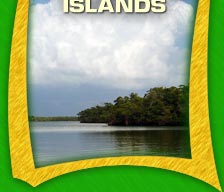


 |
||
MUCHO MANGROVES Located on the outer edges of the islands, a Red Mangrove’s aerial prop roots not only stabilize soil, but also filter salt and other harmful chemicals from the water. Black Mangroves have a much darker bark and finger-like roots, called pneumatophores that stick straight up from the mud, allowing the roots to breathe even when submerged. White Mangroves are found on higher, dryer grounds and
have special leaves that contain salt-secreting glands. Although
not considered a true mangrove by many, Buttonwoods are
hard-wood, salt-tolerant trees whose seedpods have a button-like
appearance. These brackish-water plants make ideal habitats
for a host of endangered species. WATER BALANCE Now federal, state and local agencies are working
on restoring the region’s natural sheetflow as part of the
Comprehensive Everglades Restoration Project. Currently, scientists
at Rookery Bay National Estuarine Research Reserve are collecting
baseline data on the water quality and biology of the ecosystem.
This data will be a useful tool to monitor the success of the restoration
project as managers work to create more natural waterflows. Resources for this article have been provided by Wikipedia and the US Fish and Wildlife Service. |


